

| Built for John and Lucy Fry Speed during 1815-16, this Federal-style house has an unusual plan with two central octagonal rooms (see below) and a suppressed staircase, closely resembling a plan Thomas Jefferson designed for an unidentified house. Lucy was related to George Divers, who lived at another house named Farmington, designed by Jefferson, which Lucy had undoubtedly seen. It is thought that Lucy would have wanted a sophisticated home like those she had known in Jefferson's Virginia. | ||
Distant viewsFarmington was the main house of a 550 acre hemp plantation, hemp being a major cash crop in this part of Kentucky. It was built local wood and brick made in the area and probably constructed largely by slaves. |
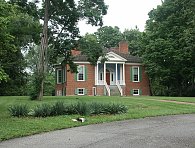
|
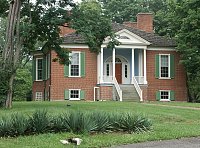
|
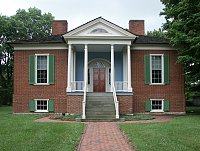
|
The front--facing southwestThe front facade also resembles Villa Emo by the sixteenth century Italian architect, Andrea Palladio, who was one of Jefferson's favorite architects. The resemblance is especially evident in the Doric portico, here more open and delicate than in Palladio's larger villa. The porch is supported by slender unfluted Doric columns, with a simple necking and tall base. The grand pediment has a half-round window in the tympanum. Recent paint analysis revealed that the inner porch facade had been blue, indicating that the Speeds had used it as a sitting porch. Green shutters were common in Federal-style southern homes, as was faux-grained wood, used throughout the interior as well. | |
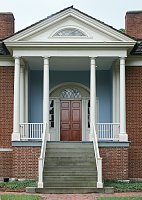
|

|

|
The entranceOver the recessed door is a fanlight with delicate mullions. Small swag patterns decorate the molding around the light. Side lights, flanking the door, are bordered by engaged Doric colonettes. The panels in the front door are faux-grained. |
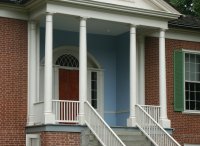
|

|
A masonry plantationThe brick is laid in Flemish bond, the preferred and more expensive bond used in southern homes prior to the Civil War. The brick patterns above the windows are in a flat (gauged) arch and a string course at floor level is probably a water table, used to divert rain water from the building. The windows of the main floor--the piano nobile--are nine-over-nine sash windows. Louvered shutters are used for the main floor windows as well. | ||

|
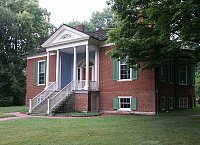
|
Oblique views showing the octagonal rooms in the center of the planThe house is absolutely symmetrical so there are two doors leading to the basement, opposite each other under the front staircase. |
 Click here to return to index of art historical sites.
Click here to return to index of art historical sites.
 Click here to return to index of artists and architects.
Click here to return to index of artists and architects.
 Click here to return to chronological index.
Click here to return to chronological index.
 Click here to see the home page of Bluffton University.
Click here to see the home page of Bluffton University.
